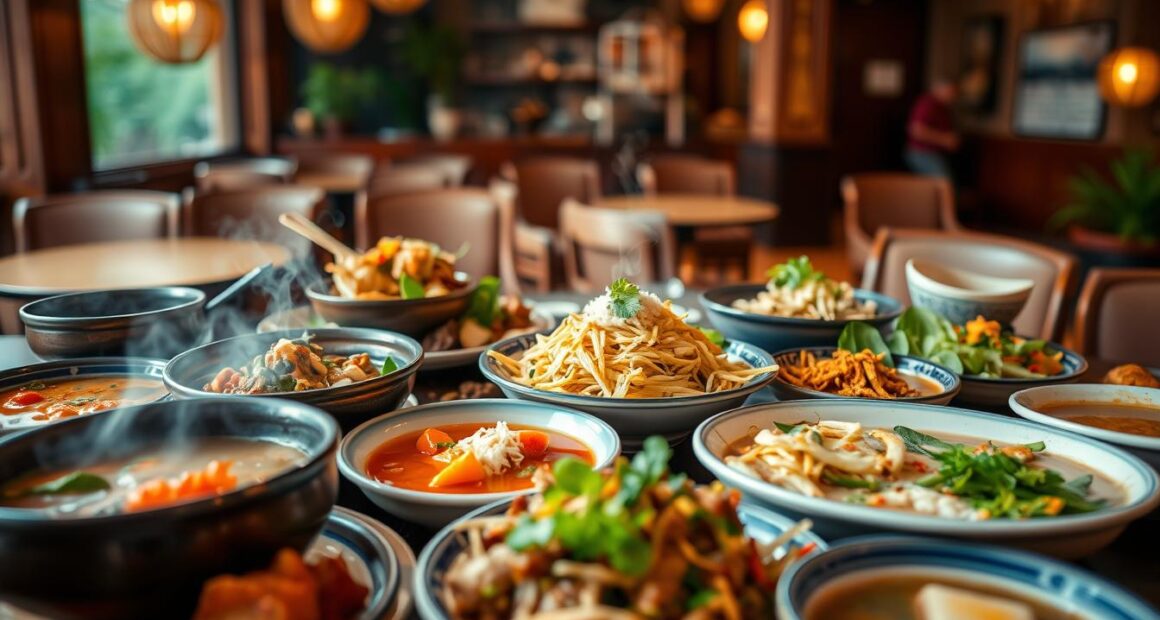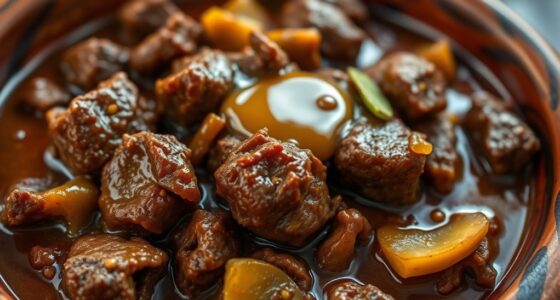Imagine stepping into a bustling market in Bangkok, where the tantalizing aroma of spices dances through the air, each scent pulling you deeper into the heart of Thai culture. It’s more than just food; it’s a fiesta of flavors that awaken your senses and create connections with every bite. Thai cuisine isn’t just about meals; it’s about shared moments, vibrant traditions, and the artistry of balancing taste and texture. From the comforting warmth of a bowl of Tom Yum Goong to the sweet, satisfying finish of Mango Sticky Rice, each dish tells a story. In this article, you’ll discover the must-try dishes of authentic Thai cuisine that not only nourish your body but also your spirit.
Key Takeaways
- Thai cuisine offers a vibrant mix of bold flavors, making it a culinary treasure.
- Must-try dishes include Pad Thai and Tom Yum Goong for an authentic taste experience.
- Mango Sticky Rice stands out as a beloved dessert that perfectly pairs sweetness with tradition.
- The use of fresh ingredients and spices enhances the complexity of Thai food.
- Exploring regional dishes reveals the rich cultural diversity within Thai cuisine.
Introduction to Thai Cuisine
Thai cuisine is a vibrant tapestry of flavors and ingredients, reflecting the unique food culture of Thailand. Its distinguishing feature lies in the captivating combination of five main flavors: salty, sweet, sour, bitter, and spicy. This balance of flavors plays a crucial role in making each dish appealing and satisfying. Where else can you find noodles, rice, and a multitude of meats or fish, all harmonizing perfectly on one plate? The importance of freshness and quick cooking methods allows the colors and textures of the food to shine, making thai food aesthetically pleasing.
What Makes Thai Cuisine Unique?
One of the hallmarks of authentic thai cuisine is its emphasis on communal dining. A typical meal includes a wide variety of dishes allowing everyone to share and explore different tastes. Rice serves as the centerpiece, with Jasmine rice being the preferred choice, albeit at a higher cost. Stickiness defines glutinous rice, while white rice remains affordable and abundant. Soups are often enjoyed individually, highlighting personal flavor preferences.
Key Ingredients Used in Thai Cooking
Understanding the core ingredients in thai food is vital for creating genuine flavors. Ingredients such as fish sauce, tamarind, and coconut milk add depth and authenticity. Fresh herbs like basil, cilantro, and lemongrass are essentials, contributing aromatic qualities to many dishes. Thai cooking employs a range of techniques that prioritize the retention of these vibrant characteristics. Whether you’re replicating a traditional recipe at home or engaging with the lively street food scene, knowing these key components invites a deeper appreciation for Thailand’s culinary artistry.
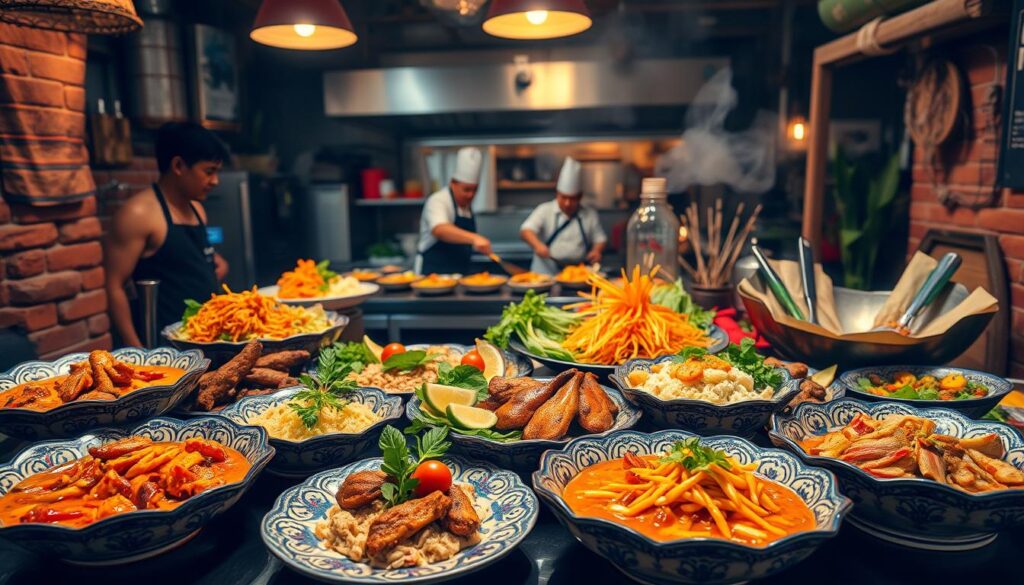
Popular Thai Dishes
Thai cuisine is a rich tapestry of flavors and textures, celebrated for its balance between spicy, sweet, sour, and salty elements. Among the most popular Thai dishes, each one tells a story and showcases the ingredients that define classic Thai recipes. Let’s dive into three standout dishes that you simply must try.
Pad Thai: The Classic Stir-Fry
Pad Thai holds the crown as a beloved classic among popular Thai dishes. This stir-fry features rice noodles combined with shrimp, chicken, or tofu, and is expertly flavored with tamarind paste, fish sauce, and a hint of sugar. The dish is often garnished with crushed peanuts and lime, creating a delightful combination of savory and tangy tastes. Declared the national dish of Thailand during the late 1930s, Pad Thai remains a staple street food that exemplifies the intricate balance of flavors in Thai cuisine.
Tom Yum Goong: The Spicy Shrimp Soup
Tom Yum Goong is revered for its bold, aromatic broth, bursting with the essence of spicy Thai food. This soup incorporates fresh shrimp, mushrooms, and fragrant herbs like lemongrass, galangal, and kaffir lime leaves. The hot and sour notes, enhanced by chili and lime juice, make it a refreshing choice for those seeking to experience the zing of Thai gastronomy. In 2021, the Thai government even sought recognition for this iconic dish as part of the nation’s cultural heritage, highlighting its importance in Thai cooking.
Green Curry: A Flavorful Delight
Green Curry is known as one of the spiciest curries in Thai cuisine, delivering a vibrant and flavorful punch. Made with green chilies, coconut milk, and a variety of fresh herbs, this dish offers an explosion of taste that is both fragrant and fiery. The first recorded recipe for green curry dates back to a cookbook published in 1926, showcasing its long-standing place in classic Thai recipes. Perfect with jasmine rice, Green Curry embodies the freshness of Thailand’s culinary landscape.
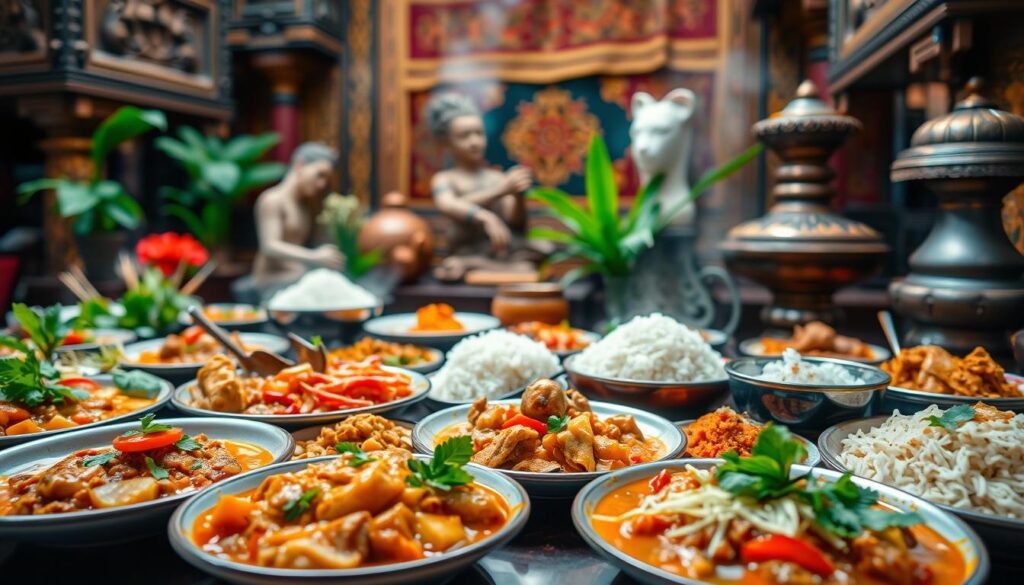
Rice Dishes to Relish
Rice holds a significant role in Thai cuisine, acting as a cornerstone that complements a variety of flavors. Among the array of thai rice dishes, jasmine rice stands out as a beloved choice, revered for its fragrant aroma and fluffy texture. Diners will often find this delightful variety accompanying many meals, enhancing both taste and experience. Another staple, sticky rice, remains an essential part of traditional thai recipes, particularly cherished for its unique texture and versatility in pairing with various dishes.
Jasmine Rice: The Perfect Pairing
When it comes to authentic Thai meals, jasmine rice is the go-to option for many. This long-grain rice not only adds an aromatic dimension to the meal but also serves as an excellent foundation for savoring robust sauces and flavors. Often, a standard serving includes approximately 1.5 cups of cooked jasmine rice, making it a generous side dish that suits both casual dinners and festive occasions.
Sticky Rice: A Traditional Favorite
Sticky rice, a staple in many regions of Thailand, is particularly popular in the north. This glutinous rice is typically served with both savory and sweet toppings, highlighting its adaptability. Common pairings include grilled meats, fragrant curries, or even desserts, showcasing the diverse ways that rice can play a star role in traditional thai recipes. It’s a delightful experience to enjoy sticky rice wrapped in banana leaves, adding even more authenticity to the dining experience.

Thai Street Food: An Experience Like No Other
Exploring thai street food offers an adventure for your taste buds. Urban areas, especially Bangkok, are bustling with vendors serving authentic street snacks. These dishes not only provide a culinary delight but reflect the vibrancy of Thai culture. You can dive into an array of flavors that embody the spirit of Thailand with each bite.
Satay Skewers: A Grilled Treat
One classic item you cannot miss is the satay skewers. Tender marinated meat grilled to perfection and served with a rich peanut sauce creates the ultimate snack experience. This dish is widely available and frequently found at the best thai restaurants, making it a beloved favorite among locals and tourists alike.
Som Tum: A Spicy Papaya Salad
Som Tum, or green papaya salad, delivers a refreshing crunch paired with spicy and tangy flavors. This vibrant dish often showcases the use of fresh ingredients, making it a perfect choice for hot days or beach outings. Whether enjoyed at a food stall or the best thai restaurants, Som Tum highlights the culinary diversity available through authentic street snacks.

Exceptional Thai Soups
Thai cuisine is renowned for its vibrant and aromatic flavors, with soups playing a central role. Two standout examples, Tom Kha Gai and Larb, highlight the diversity and richness found in authentic Thai soups. Whether you prefer a comforting bowl of coconut chicken soup or a refreshing minced meat salad, these dishes offer remarkable experiences for your taste buds.
Tom Kha Gai: Coconut Chicken Soup
Tom Kha Gai is a beloved choice among fans of authentic Thai soups. This comforting bowl combines chicken with coconut milk, lemongrass, galangal, and kaffir lime leaves, creating a fragrant and flavorful dish. Preparation takes only 15 minutes, followed by 25 minutes of cooking, making it a quick meal option. This spicy Thai soup typically serves four, with each serving containing approximately 332 calories.
| Ingredients | Amount |
|---|---|
| Boneless, skinless chicken thighs | 1 lb |
| Chicken stock | 2 cups |
| Coconut milk | 1½ cups |
| Galangal | 12 thin slices |
This dish is gluten-free and can easily be made vegan by substituting chicken with tofu and chicken broth with vegetable broth. To ensure optimal flavor retention, avoid adding lime juice and herbs when storing leftovers, which can last up to a week in the refrigerator. Once you try this delicious spicy Thai soup, it may become one of your go-to comfort food choices.
Larb: A Zesty Minced Meat Salad
Larb is another exceptional dish that showcases the complexity of Thai flavors. Made with minced meat, typically chicken or pork, this vibrant salad incorporates fresh herbs and a zesty lime dressing. The playful combination creates a dish that is both refreshing and bursting with flavor. Often served warm or at room temperature, larb is perfect as a starter or as a main dish with rice.
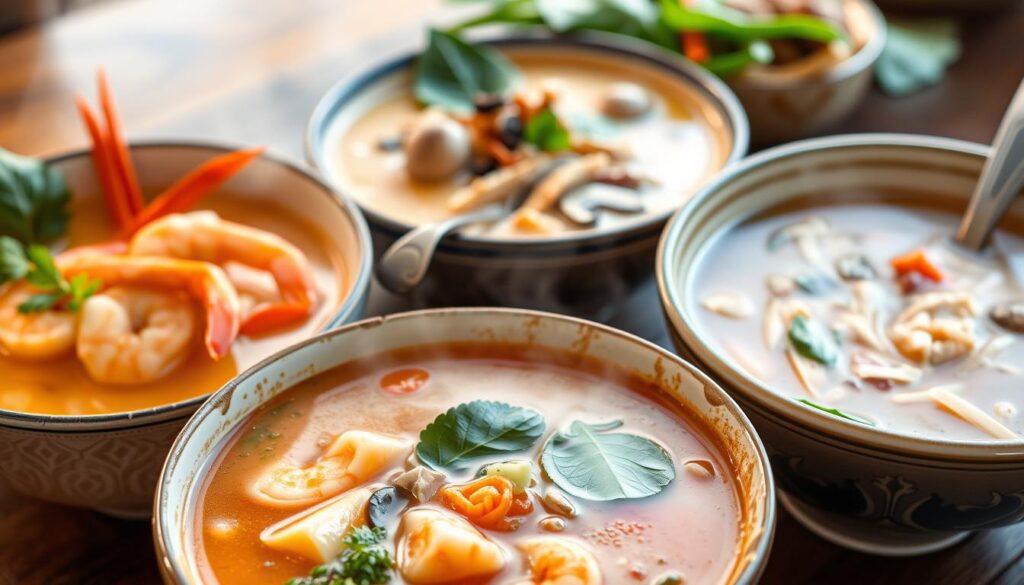
Curries: Spice Things Up
Thai curries present a delightful exploration of flavor and spice that accurately embodies the essence of spicy Thai food. This category provides a wide array of traditional curry recipes, each offering a unique taste experience influenced by regional ingredients and cultural backgrounds. The versatility of these dishes truly showcases the ingenuity found in Thai cooking.
Massaman Curry: A Unique Blend
Massaman curry stands out due to its unique combination of Thai and Middle Eastern flavors. This rich dish features a blend of spices including cinnamon, cumin, and cardamom, which come together to create a hearty meal. Often enriched with coconut milk and whipped creamy textures, Massaman curry contains meat, potatoes, and peanuts, allowing it to stand alone as a satisfying main course. Enjoying this curry provides a clear representation of how diverse thai curries can be.
Penang Curry: Deepen Your Flavor Palette
Penang curry distinguishes itself with its luscious and sweeter sauce, tapping into the heart of what makes spicy Thai food so enjoyable. A base of coconut milk pairs perfectly with crushed peanuts and a harmonious mix of spices. The balance of heat and sweetness creates a flavor profile that is both indulgent and complex. This curry is often served with chicken or beef, highlighting the rich nature of traditional curry recipes. Every bite invites you to explore the deep flavors that signify the authenticity of Thai cuisine.
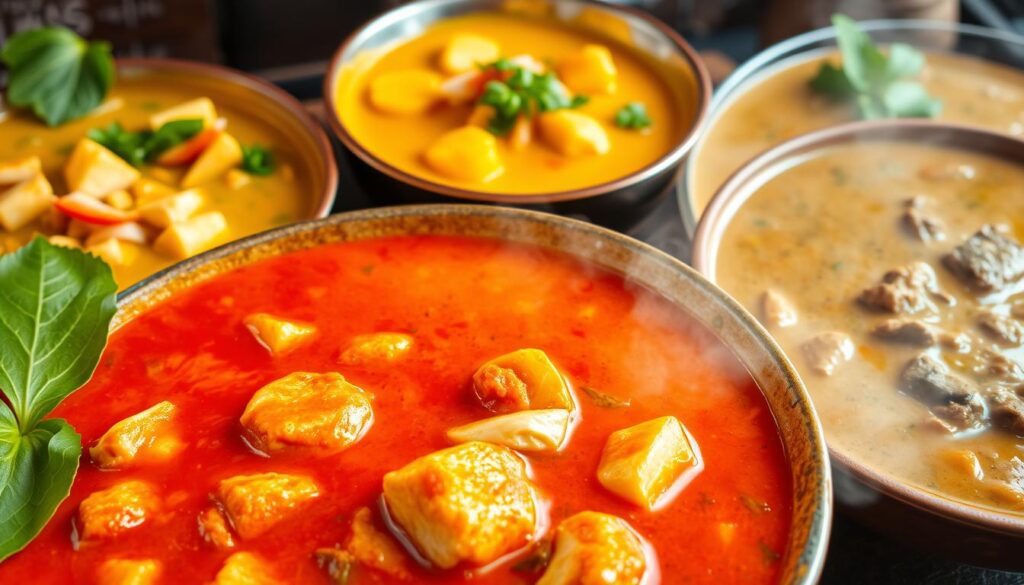
Vegetarian and Vegan Options
Thai cuisine offers a treasure trove of vegetarian and vegan dishes, providing vibrant flavors and healthy alternatives. With a rich tradition rooted in Buddhist customs, many dishes are naturally plant-based. In cities like Bangkok and Chiang Mai, you’ll find numerous vegan Thai restaurants bustling with fresh ingredients and imaginative recipes. Exploring vegetarian thai dishes allows you to enjoy the bold tastes and exotic flair associated with this remarkable culinary heritage.
Thai Basil Tofu: A Plant-Based Must-Try
For a delightful meal, consider Thai Basil Tofu. This dish features tofu stir-fried with a medley of fresh basil, bell peppers, and green beans. It’s a perfect fit for those seeking vegan options while still enjoying authentic Thai flavors. The aromatic herbs and spices infuse the tofu with vibrant taste, making it a standout among healthy thai recipes.
Vegetarian Pad See Ew: Stir-Fried Noodles
Vegetarian Pad See Ew offers a hearty and satisfying experience. Made with wide rice noodles, fresh vegetables, and a savory soy sauce, this dish can easily be adapted to suit your preferences. When ordering, just ensure to request it without egg and fish sauce, transforming it into a delicious vegan meal. Pad See Ew exemplifies how traditional vegetarian thai dishes can be both fulfilling and enjoyable.

Sweet Endings: Thai Desserts
No Thai meal feels complete without indulging in a delightful dessert. The abundance of tropical ingredients in Thai desserts introduces exciting flavors and textures that elevate your dining experience. Among these, mango sticky rice stands out as a cherished favorite, while coconut ice cream encapsulates the essence of tropical sweets. Both options seamlessly complement the rich and spicy profiles of main courses, offering a satisfying conclusion to your meal.
Mango Sticky Rice: A Cherished Favorite
Mango sticky rice, known as Khao Niew Ma Muang, is undoubtedly a defining dessert of Thai cuisine. This iconic dish features ripe mango slices accompanied by sweet sticky rice drizzled with creamy coconut sauce. Available year-round, it is especially delightful during mango season when the sweetness peaks. This dessert is naturally gluten-free and dairy-free, catering to a variety of dietary preferences.
Coconut Ice Cream: A Tropical Treat
Coconut ice cream embodies the tropical essence of Thailand, crafted with fresh coconut milk to deliver a rich, creamy flavor. Often enhanced with assorted toppings, such as roasted peanuts, coconut flakes, or sweet sticky rice, it offers a refreshing respite from the heat. Many find joy in enjoying coconut ice cream served in the shell of a young coconut, adding to the overall presentation and experience.
| Dessert | Main Ingredient | Notable Features |
|---|---|---|
| Mango Sticky Rice | Ripe Mango | Sweet sticky rice and coconut cream; gluten-free |
| Coconut Ice Cream | Coconut Milk | Rich and creamy; often served in a coconut shell |
| Coconut Jelly | Coconut Water | Made with agar-agar; vegan-friendly |
| Thai Crispy Pancakes | Coconut Cream | Popular street food with sweet fillings |
| Tapioca Pearls in Coconut Milk | Tapioca Pearls | Warm, creamy dessert sweetened with palm sugar |
| Steamed Banana Cake | Bananas | Soft and moist with coconut milk |

Regional Specialties of Thai Cuisine
Exploring the diverse landscape of Thai cuisine reveals regional specialties that showcase a rich tapestry of flavors and cooking techniques. Each area brings forth its own distinct characteristics, utilizing unique ingredients that define local dishes. Whether you are indulging in the milder, comforting flavors from the north or savoring the fiery, salty profiles of the south, understanding these regional Thai dishes enhances your culinary experience.
Northern Thai Dishes: A Distinct Flavor
Northern Thai cuisine reflects influences from neighboring countries like Laos, Myanmar, and China, offering a unique flavor profile that’s distinct from other regions. The staple food, khao niaow (sticky rice), contrasts with the white rice consumed elsewhere, emphasizing local traditions. Northern dishes often blend sour and bitter notes with a lesser emphasis on saltiness, creating a different taste experience.
- Khao Soi: A beloved dish featuring both egg noodles and crispy fried noodles.
- Fresh Vegetables: Highlighting a high use of foraged ingredients and fresh produce.
- Larb: This zesty minced meat salad showcases the region’s vibrant flavors.
Southern Thai Cuisine: The Spicy Side
Traveling to Southern Thailand takes you into the realm of spicy and bold flavors. This region is known for its use of fish sauce and an abundance of seafood, making it the spiciest area of the country. Southern curries, thicker and spicier than their northern counterparts, often feature coconut milk, showcasing the area’s unique produce.
- Coconut and Pineapple: Commonly used ingredients reflecting the region’s agricultural strengths.
- Isaan Sausage: A famous street food that combines savory, sour, and slightly sweet flavors.
- Hor Mok: A traditional fish mousse, perfectly steamed in banana leaf cups.

As you delve into these regional Thai dishes, you’ll discover how traditional flavors and unique ingredients create a culinary adventure that resonates with the heart of Thai culture. Embrace the opportunity to explore both the mild comfort of the north and the exciting spice of the south as you taste your way through Thailand.
Crafting Authentic Thai Dishes at Home
Bringing the vibrant flavors of Thailand into your kitchen can be an enriching experience. By mastering essential cooking techniques and making thoughtful ingredient substitutions, you can recreate authentic Thai recipes with confidence. Whether you’re stir-frying fresh vegetables or simmering a rich curry, these approaches enhance your culinary skills and help you savor the true essence of Thai cuisine.
Essential Cooking Techniques for Thai Cuisine
To achieve the best results in your authentic Thai recipes, you might focus on several key cooking techniques:
- Stir-Frying: A fast and effective method for cooking ingredients over high heat to preserve flavor and texture.
- Steaming: Ideal for dim sum and desserts, this technique maintains the natural flavors and nutrients.
- Simmering: Perfect for creating rich broths and curries, allowing flavors to meld beautifully.
Ingredient Substitutions for Home Cooks
Sometimes, you may not have access to traditional Thai ingredients. Here are some practical ingredient substitutions to consider:
| Original Ingredient | Substitution |
|---|---|
| Fish Sauce | Soy Sauce |
| Rice Flour | All-Purpose Flour |
| Fresh Thai Basil | Sweet Basil |
| Tofu | Chicken or Beef |
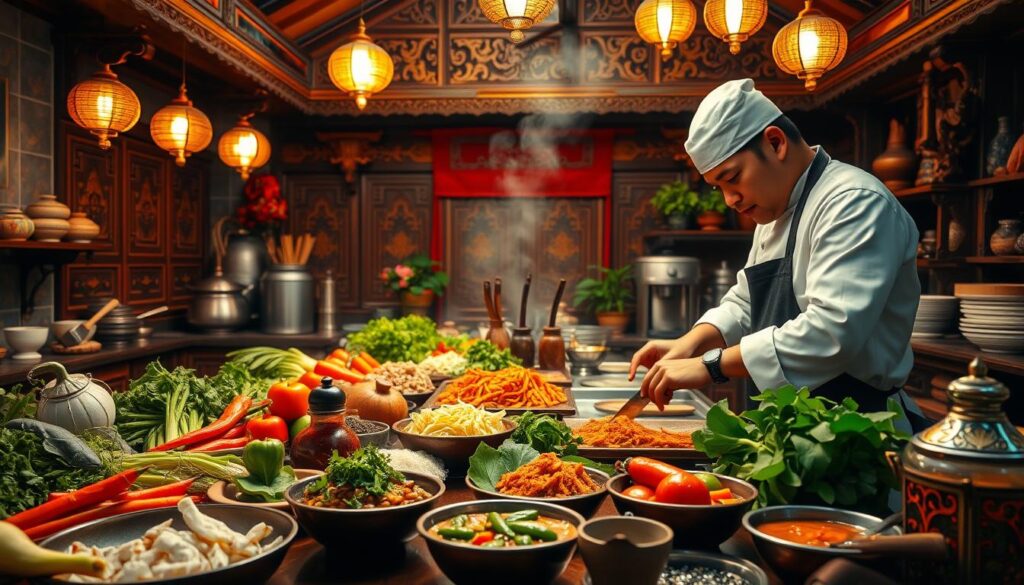
Dining Etiquette in Thailand
When exploring dining etiquette in Thailand, you enter a world where meals are not merely about nourishment but serve as a means to foster connection. Central to this experience is the practice of meal sharing, which emphasizes communal enjoyment and cultural norms that guide how food is approached and experienced. Understanding these guidelines can elevate your dining experience and deepen your appreciation for Thai culture.
Understanding the Importance of Sharing
In Thailand, dining is a communal experience, often characterized by the sharing of 3-5 dishes among friends or family. Meals typically revolve around a base of rice, with the expectation that each bite incorporates rice to enhance flavor and balance. Thai curries, generally thin and soupy, complement the lighter textures associated with rice dishes, contrasting notably with richer Indian counterparts.
A notable aspect of meal sharing is the practice of taking smaller portions, which allows everyone to sample a variety of flavors while minimizing waste. It is polite to refrain from taking the last portion from a serving bowl, traditionally preserved for the host or senior members of the group. This practice not only fosters a sense of respect but also enhances the overall experience of dining together.
Tips for Enjoying Your Meal
To align with dining etiquette in Thailand, consider these helpful tips during your meal:
- Wait for the host or the most senior person to begin eating before you start.
- Use a spoon in your right hand and a fork in your left for most dishes, reserving chopsticks for noodle soups.
- Sticky rice, due to its texture, is often eaten with your fingers, but your left hand should not touch food.
- Maintain a slow pace while eating, encouraging conversation and social interaction.
- Be mindful of how you handle your utensils; Thai food is usually pre-cut, eliminating the need for a knife.
Following these guidelines creates a respectful atmosphere that values the essence of communal dining. As you immerse yourself in the rich tapestry of Thai culture, each shared meal becomes not just an occasion for filling your stomach, but a harmonious blend of flavors and connections ignited through mutual respect.

Popular Thai Restaurants in the U.S.
Exploring the vibrant landscape of Thai cuisine across the United States reveals numerous must-visit spots that offer authentic Thai cuisine. With options available in major cities like Los Angeles and New York, dining out becomes an adventure filled with a variety of flavors and aromas. Many establishments emphasize traditional recipes and quality ingredients, making it easy to find the best Thai restaurants that resonate with your taste buds.
Must-Visit Spots for Authentic Thai Cuisine
When it comes to finding exceptional Thai dining experiences, several restaurants stand out:
- Lotus of Siam: Renowned as a culinary institution in Nevada, this restaurant frequently receives accolades from various publications.
- Jitlada: Known for a staggering menu of 300 items, this restaurant underwent a transformation after being acquired by chef Suthiporn “Tui” Sungkamee, bringing a wealth of new flavors to the table.
- Langbaan: Offers a unique tasting menu priced at $105 per person, showcasing a mix of traditional and contemporary dishes.
- Thai Kun: Recognized on the Bon Appétit Best New Restaurants List in 2014, this spot emphasizes authenticity in every dish.
- Bambu Asian Cuisine: Features dishes like Crying Tiger Beef, which incorporates Isan grilling techniques, celebrating the cultural diversity of Thai food.
- Little Serow: Provides a delightful seven-course tasting menu that highlights the flavors of Northern Thai cuisine.
How to Find the Best Local Thai Restaurants
Finding the best local Thai restaurants can be achieved through a few reliable methods:
- Search online review platforms to compare ratings and recommendations from other diners.
- Ask locals for suggestions, as they often know hidden gems that may not be widely advertised.
- Explore Thai neighborhoods, which usually feature a concentration of authentic offerings.
Diving into authentic Thai cuisine keeps the dining experience fresh and exciting, allowing you to find your favorites no matter where you are in the country.
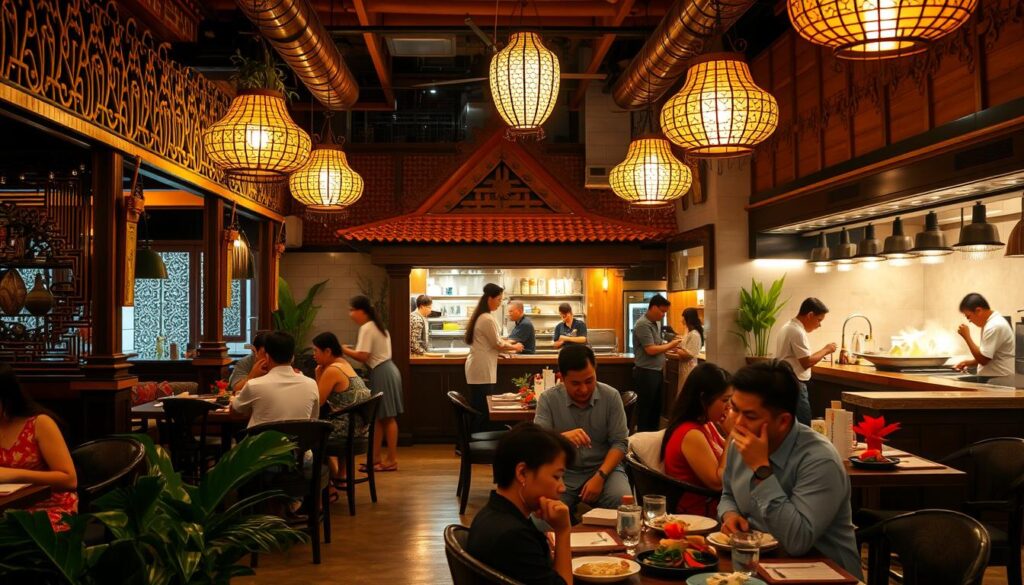
Combining Thai Flavors with Other Cuisines
Thai cuisine excites the palate with its vibrant flavors, making it a delightful candidate for fusion cuisine. The balance of sweet, sour, salty, and spicy flavors creates a unique culinary experience. Incorporating traditional Thai elements into beloved American dishes opens doors for your thai food exploration. Imagine a Thai-inspired burger featuring lemongrass-infused patties or tacos garnished with a tangy mango salsa. These innovations encourage culinary creativity while celebrating the essence of Thai flavors.
Fusion Dishes: Thai Meets American Cuisine
As the culinary world embraces fusion cuisine, many chefs are blending Thai ingredients with familiar American favorites. Classic recipes often receive a Thai twist:
| Dishes | Thai Elements | Flavor Profile |
|---|---|---|
| Burgers | Lemongrass, chili mayo | Spicy, savory, herbaceous |
| Tacos | Mango salsa, fish sauce | Sweet, tangy, refreshing |
| Mac and Cheese | Coconut milk, green curry paste | Creamy, fragrant, unique |
| Pizza | Thai basil, peanut sauce | Herbaceous, nutty, adventurous |
Tips for Experimenting with Flavors
Venturing into fusion cuisine can be thrilling. To enhance your culinary creativity, consider these tips:
- Experiment with ingredients: Swap traditional bases with Thai staples like coconut milk or fish sauce.
- Balance the flavors: Aim for sweet, sour, salty, and spicy to emulate authentic Thai dishes.
- Use fresh herbs: Incorporate Thai herbs, such as basil or cilantro, for an aromatic twist.
- Adjust spice levels: Introduce elements like bird’s eye chilies to infuse heat while maintaining a familiar taste.
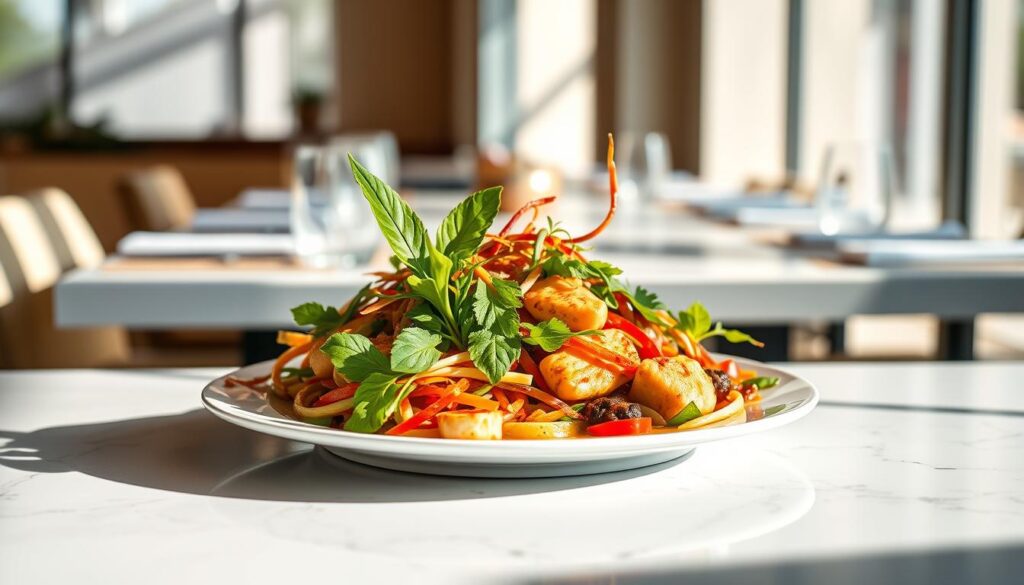
Conclusion: Your Path to Thai Cuisine Adventure
Embarking on a journey to explore Thai cuisine opens your palate to an extraordinary culinary adventure filled with diverse flavors. Thai food, which has deep roots tracing back to the ancient Kingdom of Sukhothai, boasts a unique harmony of four key flavors: sweet, sour, salty, and spicy. Each dish tells a story of tradition and innovation, making it essential to appreciate the culinary heritage behind this beloved cuisine.
Embracing the Diversity of Thai Food
In your quest to explore Thai cuisine, you will encounter a variety of ingredients that elevate each dish. Fresh herbs such as basil and lemongrass, along with spices like ginger and turmeric, create a vibrant tapestry of tastes. Renowned establishments like Thai Luang Restaurant in Herndon, Virginia, offer a perfect glimpse into this rich culinary world. Here, you can savor dishes like crispy duck or the succulent wild jumbo shrimp, all while enjoying the inviting decor that complements the experience.
Encouragement to Try New Dishes
Stepping outside your comfort zone to try new dishes can be a rewarding experience. Street food in Bangkok serves as a testament to the lively and approachable nature of Thai cuisine. Vendors expertly prepare favorites like moo ping and som tum, showcasing the ability to deliver fresh and bursting flavors in no time. Embrace the adventure of Thai cuisine and indulge in the delicious offerings waiting to be discovered.
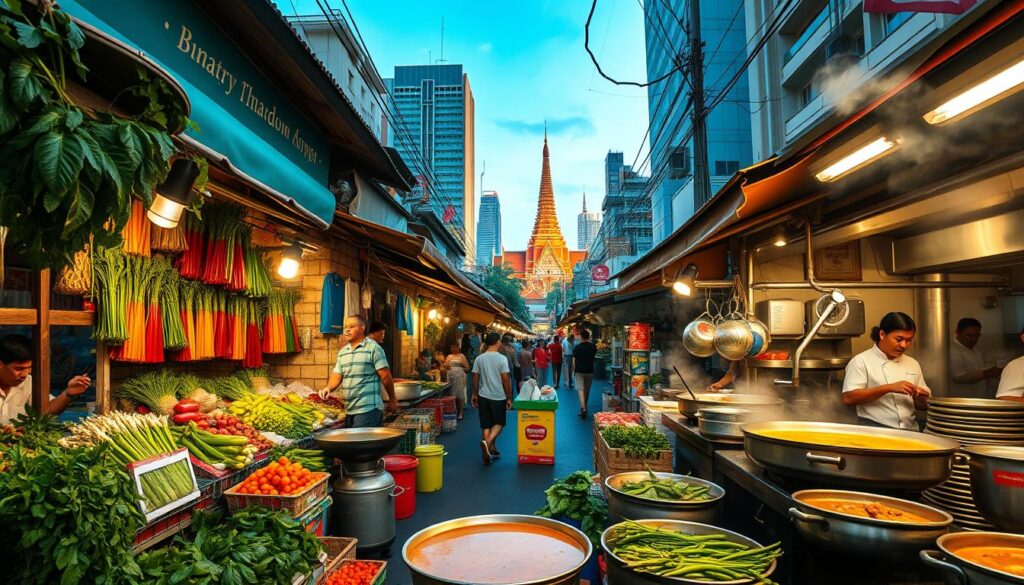
Resources for Further Exploration
If you’re looking to deepen your understanding of Thai cooking, there are plenty of thai cooking resources that can guide you on your culinary journey. The world of culinary literature is rich with cookbooks that not only offer authentic recipes but also provide insights into the traditional techniques that define Thai cuisine. Whether you’re a beginner or an experienced home cook, these books can enhance your skills and appreciation for the vibrant flavors of Thailand.
Books and Cookbooks on Thai Cooking
Some exceptional cookbooks cover various aspects of Thai food, highlighting regional specialties and classic dishes. Authors like David Thompson, who is known for his expertise in Thai cuisine, present readers with thoughtful narratives alongside mouthwatering recipes. These resources are invaluable for anyone eager to learn thai recipes that showcase the complex interplay of sweet, sour, salty, and spicy profiles unique to this culinary tradition.
Online Resources for Learning Thai Recipes
In addition to books, the digital landscape offers a plethora of online platforms where you can learn thai recipes through engaging tutorial videos and blogs. Many cooking communities provide a space for enthusiasts to share tips, experiences, and advice. By utilizing these online resources, you not only broaden your cooking repertoire but gain a sense of community while embracing the flavors of Thai cuisine.
